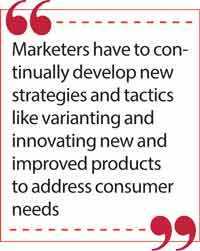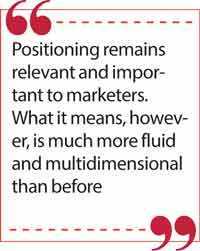Wednesday Mar 05, 2025
Wednesday Mar 05, 2025
Friday, 9 April 2021 00:00 - - {{hitsCtrl.values.hits}}

Clogard’s offering has widened while remaining within the same positioning space
 |
 |
|
Hemas Manufacturing Director - Marketing FionaJuriansz Munasinghe |
 |
| Baby Cheramy’s positioning has evolved and brings more inclusivity to its imagery
|
Brand strategy is central to business strategy to drive business performance and commercial impact. But today, the fastest-growing organisations no longer think of brand positioning as a static, category-based, abstract construct to be checked and reviewed every so often. Instead, they move along an overall trajectory of purpose that brings the business, brand and customer closer than they’ve ever been. The idea that enduring competitive advantage can be created by repeatedly doing the same thing, no matter how efficiently, has disappeared forever. The age of brand positioning is drawing to an end.
Michel Nugawela asks Hemas Manufacturing Director - Marketing Fiona Juriansz Munasinghe for her opinion on the ongoing relevance of positioning to establish a brand within a target market. Following are excerpts from the interview:
Staying ahead of the curve
At its simplest, positioning is the place a brand occupies in the mind of the consumer, relative to the alternatives offered by its competitors. The construct is over 50 years old and the ongoing debate about whether it remains a powerful tool for competitive strategy has to do with the fast-changing and complex nature of today’s world.
I would call a position ‘static’ when it is largely functional-driven and category-based. The fundamental issue is that now most products are similar; their functional attributes and associations – like moisturising, for example – are easily replicable.
When technological advances also level the playing field, marketers have to continually develop new strategies and tactics to stay ahead of the curve. These could include varianting, which allows a brand to stretch to new segments while retaining its core consumers, as well as innovating new and improved products to better address consumer needs.
Let’s take the toothpaste category. Clogard was introduced as a clove oil and fluoride toothpaste which blended together modern dental science with age-old herbal knowledge and natural goodness. Clogard’s offering has now evolved and widened – from cloves to the goodness of natural Sri Lankan ingredients – while remaining within the same positioning space.
Leveraging emotional states
How the brand differentiates itself by provoking the emotions of the consumer has also become important: how do they experience it and how does it make them feel? What does it say about the brand and tell them about themselves? We’re seeing a very real shift from product-functional to emotional-experiential branding that leverages the emotional state, needs and aspirations of the consumer. When this is done effectively, consumers believe the brand really understands them and adds value to their lives.
 Consider the example of Baby Cheramy. It’s a 50-year heritage brand that is positioned around ‘Precious Moments’ and targeted at first-time mothers who may experience anxiousness or lack of confidence in their skills immediately after childbirth. This is a hugely exciting and emotional life event, but it can also be overwhelming for the mother. The role of the brand is to step forward and provide her with the comfort and assurance that she is doing the right thing.
Consider the example of Baby Cheramy. It’s a 50-year heritage brand that is positioned around ‘Precious Moments’ and targeted at first-time mothers who may experience anxiousness or lack of confidence in their skills immediately after childbirth. This is a hugely exciting and emotional life event, but it can also be overwhelming for the mother. The role of the brand is to step forward and provide her with the comfort and assurance that she is doing the right thing.
Cheramy, as the name suggests, has European connotations and is associated with a safe, high quality product that is as pure as a mother’s love. The brand’s iconic imagery communicates a precious and sacred moment between a mother and the baby nestled in her arms; it is almost a protected space between themselves and the world outside.
Latterly, we see social movements such as women increasingly participating in the workforce and the breakdown of extended families and social support systems. This has resulted in the need for greater hands-on support from fathers in parenting. Many mothers today want to see the realities of parenting – it’s tough, but also the most rewarding and precious thing in the world.
 Cheramy’s strong position around the mother’s love for her baby occupied a distinctive place in the consumer’s mind; we had also built an entire ecosystem around it. However, this shift in how consumers perceived themselves and their changing roles led us to discuss whether we needed to revisit the positioning to remain relevant and keep the babies’ benefit at the heart of the discussion. Was bringing up a child primarily the mother’s responsibility or should there be more inclusivity? ‘Together in it’ was the most powerful for the baby. Ultimately we retained the ‘Precious Moments’ positioning even as we evolved and built upon it to include the father alongside the mother and the baby.
Cheramy’s strong position around the mother’s love for her baby occupied a distinctive place in the consumer’s mind; we had also built an entire ecosystem around it. However, this shift in how consumers perceived themselves and their changing roles led us to discuss whether we needed to revisit the positioning to remain relevant and keep the babies’ benefit at the heart of the discussion. Was bringing up a child primarily the mother’s responsibility or should there be more inclusivity? ‘Together in it’ was the most powerful for the baby. Ultimately we retained the ‘Precious Moments’ positioning even as we evolved and built upon it to include the father alongside the mother and the baby.
As this example shows, positioning is a journey where the marketer continually assesses whether the brand’s positioning remains relevant to the consumer today, and has the potential to remain relevant in the next five to 10 years. Since the acid test is whether they select your brand off the shelf, it’s extremely important to be attuned to the social conversations in the consumers’ world – whether it is a redefinition of priorities or lifestyle changes brought on by technology or new expectations from a younger generation.
 A community-based era
A community-based era
Today, economies are organised around platforms and everyone is part of a larger community, culture, and network. The expectations of consumers and other stakeholders has deepened in this community-based world and new constructs like brand purpose have also become integral to positioning. These are questions like why you exist beyond your product or service, what you give back to society, and how the consumer or stakeholder associated with the brand feels about themselves.
Today, it’s also about the benefit space or big idea that the brand occupies in the mind of the consumer. Brands like Apple and Amazon can extend beyond a single category because of the powerful belief system and purpose behind the brand. These brands also demonstrate that positioning, as it is practiced today, is much more multidimensional and the work marketers do is also much more integrated. Previously, your positioning had to come alive through the 4Ps or 5Ps; today, however, as brands are increasingly built by two-way conversations with their audiences through digital channels, it also becomes crucial to articulate the purpose, values and story of your organisation.
 At Hemas Consumer, we have restructured the brand teams and shifted from category to brand lenses. These have helped us look at the market from a broader consumer benefit space, both emotionally and functionally, and focus on previously underleveraged spaces. There are other advantages too, like the masterbrand approach we have adopted to managing our portfolio, with each brand feeding into the other, as well as the umbrella Hemas corporate brand.
At Hemas Consumer, we have restructured the brand teams and shifted from category to brand lenses. These have helped us look at the market from a broader consumer benefit space, both emotionally and functionally, and focus on previously underleveraged spaces. There are other advantages too, like the masterbrand approach we have adopted to managing our portfolio, with each brand feeding into the other, as well as the umbrella Hemas corporate brand.
We have also increased cross-functionality to facilitate wider conversations with a larger number of stakeholders. In the past, we placed guardrails around the brand; today, however, we are working as one team across functions such as Manufacturing, Quality, R&D, and Supply Chain so that everyone buys into what the brand stands for and is trying to achieve in the market. The brand and business have increasingly become one.
Positioning remains relevant and important to marketers. What it means, however, is much more fluid and multidimensional than before.
Discover Kapruka, the leading online shopping platform in Sri Lanka, where you can conveniently send Gifts and Flowers to your loved ones for any event including Valentine ’s Day. Explore a wide range of popular Shopping Categories on Kapruka, including Toys, Groceries, Electronics, Birthday Cakes, Fruits, Chocolates, Flower Bouquets, Clothing, Watches, Lingerie, Gift Sets and Jewellery. Also if you’re interested in selling with Kapruka, Partner Central by Kapruka is the best solution to start with. Moreover, through Kapruka Global Shop, you can also enjoy the convenience of purchasing products from renowned platforms like Amazon and eBay and have them delivered to Sri Lanka.
Discover Kapruka, the leading online shopping platform in Sri Lanka, where you can conveniently send Gifts and Flowers to your loved ones for any event including Valentine ’s Day. Explore a wide range of popular Shopping Categories on Kapruka, including Toys, Groceries, Electronics, Birthday Cakes, Fruits, Chocolates, Flower Bouquets, Clothing, Watches, Lingerie, Gift Sets and Jewellery. Also if you’re interested in selling with Kapruka, Partner Central by Kapruka is the best solution to start with. Moreover, through Kapruka Global Shop, you can also enjoy the convenience of purchasing products from renowned platforms like Amazon and eBay and have them delivered to Sri Lanka.